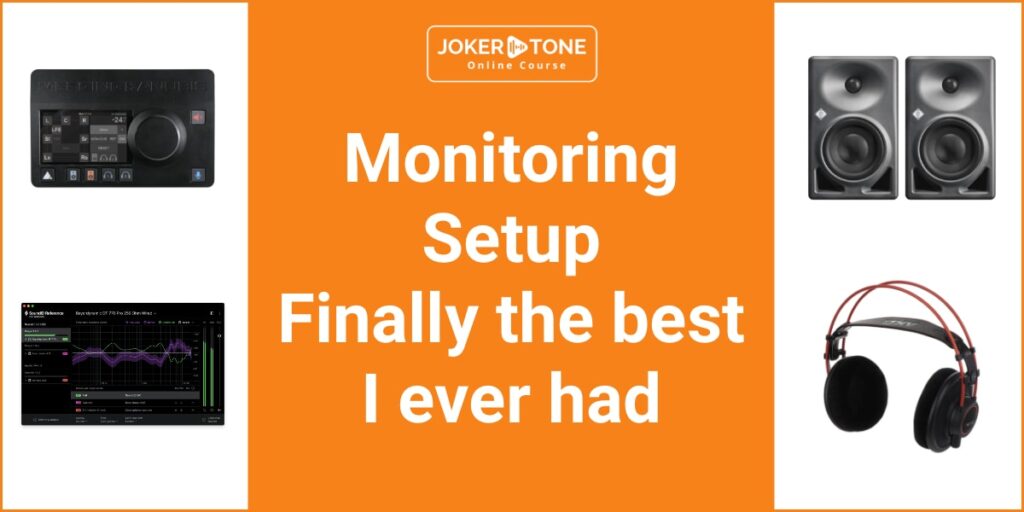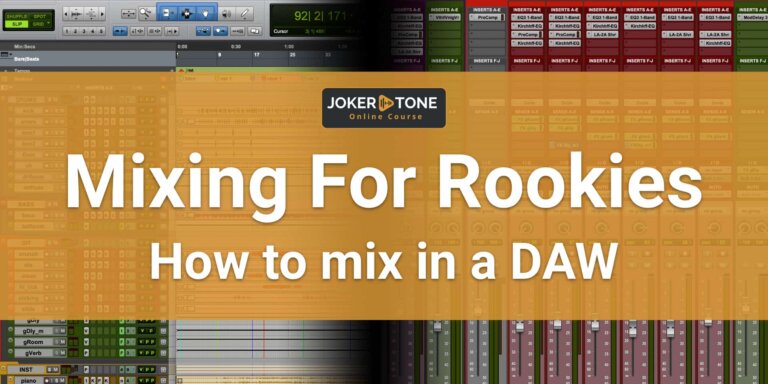Before I reach reached the best monitoring system I was already enthusiastic about mixing and mastering and supported other artists with their projects. I started as a musician who wanted to record his first songs with his band. The first recordings with a sound engineer outside of the band were very sobering for all of us, so I took over the recording and mixing process.
Since I still had an analog mixing console as the control center for my first real recording setup, I hardly had to worry about latency during recording. With the advent of the digital era, which is now indispensable, so many advantages were added that I would no longer want to do without. Editing alone, the visual aspect presets, and many other things that make digital music production so much easier. However, without a DSP-based interface, it was simply not possible to get close to near-zero latency-free monitoring when using different types of plug-ins. And of course, the computer and its processing power always had to play along.
PCs and Macs have become faster and faster, and the connections with Thunderbolt or USB-C also have sufficient bandwidth for the audio range. Even with USB 2, this was given with a human number of tracks), but despite all these possibilities, all components together form a chain that influences the latency.
The desired requirements for the best monitoring system
The following important factors had to be fulfilled for my monitoring system:
- Near zero latency monitoring during tracking: I simply didn’t want to worry about whether, which, and how many plug-ins were already in the session when I wanted to make an additional recording. The routing in the session always influenced the latencies of buses or groups. I also found it practical to create a sound during recording and record it directly. If it was possible to use DSP plug-ins directly on the interface and record them, this would be a plus for me.
- Integration of room correction software: I realized relatively late in the journey of my productions how important the environment in which I produce is. Be it recording, editing, or mixing. You can do plenty of good things for your room and your monitoring position without spending a lot of money if you pay attention to a few basic things.
Have a look at my blog post: 5 ways to improve your monitoring setup without changing your set of speakers
Acoustic optimizations or conversions can be very costly. Even though I knew that I could build and create a lot of room optimization myself, the use of software can make it even better. In my opinion, the price performance for this is simply excellent. However, for the best monitoring system, this software must be in the monitoring path. Both for recording and mixing.
- Simple process: I need a control center. A point where the monitoring comes together. A place where I determine the source and the playback path for the speakers and the headphones. I would rather not activate or deactivate any additional tools or EQ. So it should be a “set it and forget it” setup. Of course, I was aware that I would always have to make compromises somewhere, but they should be as small as possible.
- Fewer monitoring paths in the DAW: I’ve always been a fan of structure and a clear session. Over the years, I have built various recording and mixing templates where all paths with the necessary tools were listed. Monitoring paths, recording AUX, headphone playback path for mixing and one for recording my voice, bounce paths, monitoring paths for the individual monitor pairs. I wanted to move away from this and make it more straightforward. This should be outsourced if possible.
- A pleasant headphone sound: For me, headphones always had a very intimate sound and were often too two-dimensional. Then there was the wearing comfort, which you can’t experience with every pair of headphones in the long term. For vocal recordings, however, you can’t do without them and to be able to judge and check a mix in its entirety, good headphones and comfortable headphone sound are also necessary here. Using plugins that can also make the sound in the headphones more pleasant, was a big part of this choice. So such a tool should also be usable in the monitoring path.
The software selection: Sonarworks SoundID
I am very fond of the SoundID Reference plugin from Sonarworks (Room Correction Plugin — originally SoundReference). Maybe you’ve already used it yourself or have read “good” and “bad” things about it. It is certainly not a magic tool and cannot create a perfect recording studio in a bad environment. It is not perfect and some settings and variations should also be treated with caution. However, it has always been more than helpful in my cases.
It has significantly improved my monitoring situation in each of my music rooms, and it has also always been helpful when matched to the headphones I use. I would go one step further and say that if I could only choose one 3-party plugin, it would be SoundID. It helped me to achieve the best monitoring setup.
However, at first, there was no DSP solution for SoundID (Sound References used to be the name) and I always hoped that AVID would enter into a cooperation for Pro Tools HD or Universal Audio for the Apollo interface. Unfortunately, this has not yet happened with Universal Audio. AVID has now implemented it, but only in interfaces in the high-end and high-class budget categories, which are not intended for home studios or budget-oriented options.
Short side note of my Interface journey
When I last decided on an interface, I always had direct monitoring for recording in mind. So in 2011, I switched from my first NON-DSP system (Pro Tools Digi003) to a MOTU PCIe system. After a very short time, I switched to a Universal Audio Apollo Firewire system. I used this for many years without any kind of problems.
In 2018, I thought about leaving the UAD platform because I thought it would be time for something new. I then switched to a MOTU 828es Thunderbolt for a short guest appearance and then in 2019, DAW-related, I opted for an Avid Carbon Ethernet Interface (Pro Tools related). I thought that I would have a system again for a very long time, but in the course of working with the system, some functions didn’t fit into my workflow. So in 2022, I returned to Universal Audio and got into the Apollo X Series.
But before I decided to go with the Apollo system, I did a lot of research on how to get the Sonarworks SoundID plugin into my monitoring path to create the best monitoring system and not have to use it as a plugin in the DAW.
The solution and control center: Merging Anubis
The outputs of the Universal Audio Apollo system do not go directly into my monitoring speakers, but I have connected a Merging Anubis interface in between. My two sets of monitor speakers and two sets of headphones (one for mixing and one for recording) are connected to their outputs.
The Anubis merging has 2 mic preamp/line inputs, as well as two additional line inputs and the option of connecting the computer via Ethernet to create additional digital links. This setup offers me the following options:
Individual or summed monitoring of the sources:
- Everything that is output from the UA Apollo system or the DAW via the selected interface
- Audio stream from my Mac, all sound including music from the browser and music apps
- Additional digital audio stream from Pro Tools
- Mic preamp 1 and 2
Output of the sources to
- Monitors 1 through main outputs
- Monitors 2 through line output 3/4
- and/or headphones 1
- and/or headphones 2
Merging Anubis offers the possibility to network or expand with other devices using the Ravenna protocol, but I am not currently using any of this. Only the audio stream over ethernet coming from my Mac. The Anubis became the main control hub for the best monitoring system I ever had.
The big advantages of Merging Anubis
Merging has cooperation with Sonarworks, so I can load the Sonarworks SoundID profiles onto the Anubis. The DSP chip in the Anubis offers me the option of using an output-specific SoundID profile for each output (Mon 1, Mon 2, Headphones 1, Headphones 2).
This means that I have “corrected or optimized” DSP-supported direct sound for each speaker type/headphone, with latencies that are imperceptible to me. This means also, I no longer need a SoundID plug-in in the DAW. No special routing of the monitoring channels in the DAW is required, and I am completely independent of which interface system and which DAW I use. In addition, I also listen to the sound from the computer, i.e., my music and the audio stream from browsers, directly with the SoundID profile.
Advantages:
- System, turn it on and don’t think about it anymore
- SoundID is affordable, price performance is very appealing to me
- With the Merging Anubis, I have a fall-back interface should the Apollo system ever fail.
- I also listen to the signal directly via SoundID for my tracking.
- Monitoring Mac audio sound
- Listen to multiple sources at the same time (helpful if I want to track through the Anubis)
Disadvantages:
- There is an additional AD/DA conversion
- It is another device that needs to be supplied with updates
- Merging software is rather complex and complicated to set up and update.
- Price issue (Anubis is not a low-budget solution in my eyes, but worth every penny)
- No Adat input, then I could have done without another AD/DA conversion.
Note on the latencies:
Today I always work in 24bit and 48 KHz, the following applies to my setup here:
About latencies in relation to 48 KHz for Analog Input Source (Line/Mic) to Analog Output (Monitor boxes or headphones):
- Apollo with up to 4 plugins in the channel = 2.2ms (105 samples), I hardly use more than two plugins in the Apollo chain while I record.
- Merging Anubis with SoundID applied = 1.7ms (86 samples)
- Total rounded 4ms latency
Even if there are slightly more ms latencies, I don’t notice anything less than 6ms.
Here is the procedure for direct monitoring:
Apollo IN Mic Preamp (AD conversion) → Apollo Consolo Plugins → Apollo OUT (DA conversion) → Merging Anubis IN Line (AD conversion) → SoundID Profile → Anubis OUT (DA conversion) → Monitor Box IN (analog)
Thinking about the alternatives
I am someone who thinks about alternatives before making a firm decision on a choice. The first alternative to the system listed above would be to choose a speaker system with SoundID, for example.
- The company and speaker manufacturer Adam is in cooperation with Sonarworks and also offers the option of placing a SoundID profile on the latest generation of speakers.
- Another alternative would be to supplement my existing Neumann KH120 speakers with the Neumann KH810 sub. The sub offers the option of using the Neumann M1 software, which works similarly to SoundID.
- Genelec also offers the GLM calibration software for selected monitors.
- IK Multimedia offers with their iLoud MTM another complete system of calibration software that uses DSP pairs monitor boxes.
Advantage:
- The software runs directly on the speakers, so there is no additional interface in between
- With digital speaker inputs, an additional AD/DA conversion would be spared
- Software is from the same manufacturer or their work directly hand in hand for this option to make sure that the user has a great experience with both products.
Disadvantage:
- It depends on the speakers, if you want to change your speakers, you need to replace them with an alternative that gives you the same experience
- Not much cheaper in terms of price
- Not as flexible in terms of usage
- No headphone solution
As these variants were out of the question for me due to the disadvantages mentioned, I didn’t take a closer look at the latency or the respective software. However, it might be worth taking a look at the alternatives if you are looking for a new solution on your side.
More alternatives
With a much larger budget, there are also alternative solutions to the merging interface
- AVID MTRX interface (MTRX II and MTRX Studio) can record SoundID profile
- DIRAC is another well-known company that offers DSP solutions to improve the sound quality in your listening environment.
Conclusion
After many years and various compromise solutions, I have finally found the monitoring system that meets my expectations and, above all, adapts to my workflow. I consider this to be a significant point and I have no disadvantages in the monitoring process.
It’s certainly not a cheap solution, but it was an investment that was well worth it. If I had to choose an interface and was only limited to a maximum of 2 inputs, then I would choose the Merging Anubis interface, simply because of the integration of Sonarworks SoundID.
If you have further questions or want to get in contact, please use the contact form
Niels from Joker Tone Course




